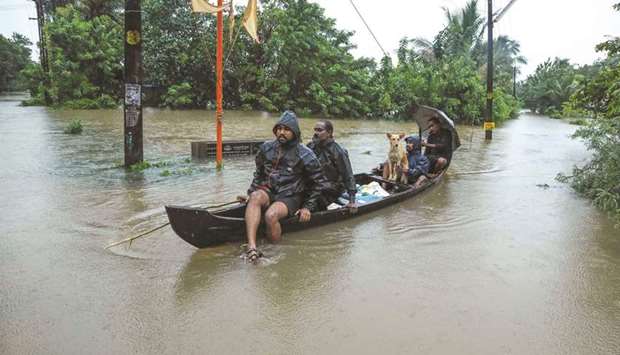The
death toll from floods in the states of Karnataka, Kerala and
Maharashtra rose to 95, official figures showed yesterday, as heavy rain
and landslides forced hundreds of thousands to evacuate their homes.
In
Kerala, some 42 people died and over 100,000 affected people have been
evacuated, the central government’s disaster management cell said, after
80 landslides hit the state in two days.
The state was yesterday
opening the gates of Banasurasagar dam in Wayanad district to manage
water levels and avoid serious damage.
Last year, more than 200 people were killed and over 5mn affected in one of Kerala’s worst floods in 100 years.
Some
residents said the sudden opening of dam gates without proper warnings
to those living downstream was a big factor in the devastation.
The
state’s busiest airport, Cochin International Airport, closed since
Friday as the taxiway was water-logged, will resume operations today
morning, the airport management said.
The maximum deaths — 15 — were
reported from Wayanad, while Malappuram, Palakkad, Idukki, Kozhikode
were other worse-hit districts, officials said yesterday. A red alert
for today has been issued in Kasargode, Kannur and Wayanad. More rain is
predicted in a few other districts.
Chief Minister Pinarayi Vijayan
yesterday took stock of the situation. Officials informed him that the
maximum number of relief camps had been set up in Kozhikode, followed by
Wayanad.
Vijayan had earlier said 80 landslides had been reported from eight worst-hit districts.
Authorities
are yet to ascertain the actual number of missing in the landslides at
Meppadi in Wayanad district and Kavalapara in Malappuram district.
According to unconfirmed reports, 41 were missing in Kavalapara, he
added.
Stating that no aerial survey could be conducted due to
inclement weather, Vijayan said as soon as the weather cleared ups the
aerial survey could be carried out.
The chief minister said despite
heavy rains, water level had increased only three dams and continued to
be low in Idukki and Pathanamthitta.
Floodgates of the Banasura dam,
which was overflowing, were opened as per the announcement and no damage
was reported as those living downstream had been shifted to secure
places.
He said all the government officials and departments engaged in relief works would be working on holidays as well.
“Cellphone towers on wheels are being set up in areas where communication has snapped,” said Vijayan.
The
railways were working overtime to start trains’ operations and army’s
help had been sought for inspection of bridges, he said.
Seasonal
monsoon rains from June to September are a crucial lifeline for agrarian
Indian society, delivering 70% of the country’s rainfall, but they also
bring in their wake death and destruction every year.
“Our entire
village under water for the last eight days but still we haven’t got any
assistance from the government,” said farmer Prashant Lathe, 35, from a
village in one of the flood-hit districts of the western state of
Maharashtra.
The district has lost access to all basic amenities such
as drinking water, power supply, cooking gas cylinder and petrol for
running vehicles, Lathe said.
Excessively strong rains can also harm India’s farming sector, which employs nearly half of its 1.3bn people.
Lathe said his sugar cane plantation of around four acres was submerged.
In
Karnataka, home to India’s tech hub Bengaluru, some 24 people have died
in what Chief Minister B S Yeddyurappa said yesterday were the worst
floods in 45 years.
Around 1,024 villages have been inundated due to
the rains, several dams were reaching their full capacity, and over
200,000 people had been evacuated, he added.
In Maharashtra, home to India’s financial capital Mumbai, 29 people have died this week.
The
Indian Meteorological Department said heavy to very heavy rain was
likely to lash isolated areas of Kerala, parts of Karnataka and
Maharashtra, and some southern states might also see extremely heavy
rain.

Residents being evacuated from their home following floods warnings in Kochi yesterday.


